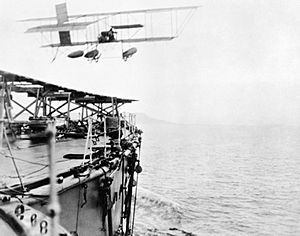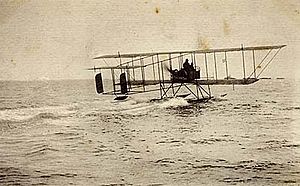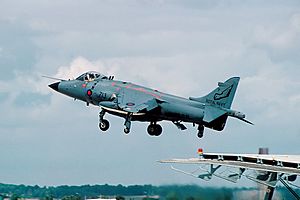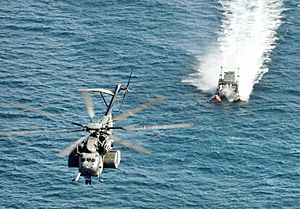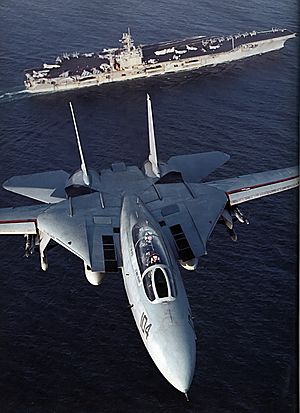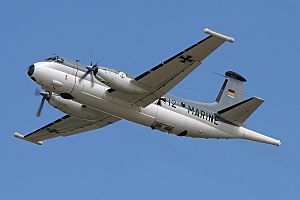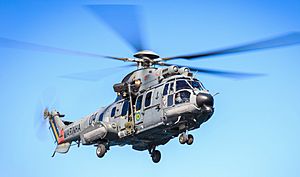Naval aviation facts for kids
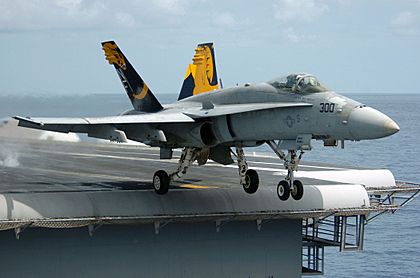
Naval aviation is when a navy uses military airplanes or helicopters. These aircraft can fly from warships, especially aircraft carriers, or from bases on land.
Aircraft that fly from carriers need to be very strong. They must handle tough landings and take-offs on a moving ship. They can launch quickly and stop suddenly on the flight deck. These planes often have folding wings to save space in the ship's hangars. Naval aircraft do many jobs, like fighting other planes, attacking ships, hunting submarines, and helping with search and rescue. They also transport supplies, check the weather, and gather information.
Naval helicopters can do many of the same jobs as planes. They can fly from aircraft carriers, helicopter carriers, destroyers, and frigates.
Contents
People started thinking about using aircraft for navies a long time ago. In 1903, the British Navy experimented with kites for scouting. They thought kites could help with wireless communication or let someone see far from high up.
In 1908, the British government decided to look into naval aviation. They agreed that large airships could be built for the Royal Navy to help with scouting. This led to the creation of Mayfly in 1909. It was the first aircraft used by the British Navy.
The first pilots for the Royal Navy joined in 1910. They started the Naval Flying School at Eastchurch, which was the first of its kind. The French Navy also started its own aviation group in 1910.
In the United States, Glenn Curtiss showed that planes could take off and land on ships. In November 1910, Eugene Ely took off from a cruiser called USS Birmingham. Two months later, he landed on another cruiser, USS Pennsylvania. This proved that planes could operate from ships. In January 1911, Curtiss flew the first seaplane from water. The next day, Theodore G. Ellyson became the first U.S. naval aviator.
The U.S. Navy bought its first three airplanes in 1911. They trained more pilots and set up a landing field near Annapolis, Maryland. Early ideas for naval aircraft included scouting for enemy ships and reporting their positions using wireless radio. There were also thoughts about attacking enemy aircraft. By 1911, Italy was also using hydroplanes for its navy.
More aviators joined the U.S. Navy and Marine Corps in the following years. They practiced with the fleet from the battleship USS Mississippi. In 1912, Henry C. Mustin successfully tested launching a plane using a catapult. In 1915, he made the first catapult launch from a moving ship. The first permanent naval air station was set up in Pensacola, Florida, in 1914.
In 1912, the British battleship HMS Africa was fitted with a special runway. On January 10, 1912, Charles Samson flew a seaplane from Africa while it was anchored. This was the first British plane to take off from a ship. Later, in May 1912, Samson flew from Hibernia while the ship was moving. This was the first time an aircraft took off from a moving ship.
These early experiments showed that aircraft could be useful for navies. However, the runways on ships got in the way of the guns, and it was hard to get seaplanes back on board in rough weather. In 1914, British naval aviation became the Royal Naval Air Service. By 1917, aircraft flying from ships were a big part of naval operations.
Germany and Russia also started naval aviation units around this time. In 1913, Japan created the Imperial Japanese Navy Air Service, similar to the British RNAS. The first wartime naval aviation mission happened in January 1913. Greek pilots used a seaplane to observe the Turkish fleet and dropped bombs on them.
When World War I began, the British Royal Naval Air Service (RNAS) was quite large. Its main jobs were scouting for the fleet, patrolling coasts for enemy ships and submarines, attacking enemy land targets, and defending Britain from air raids. In 1914, the first aerial torpedo was dropped in tests. In 1915, a British plane from HMS Ben-my-Chree sank a Turkish supply ship with a torpedo.
The first attack by a seaplane carrier against land and sea targets happened in September 1914. The Japanese carrier Wakamiya launched air raids during the Battle of Tsingtao in China. Its seaplanes bombed German targets on land and damaged a German ship.
On December 25, 1914, twelve seaplanes from British ships attacked a German airship base. This raid showed that planes could attack land targets from ships. Later, in 1918, British planes launched from the carrier HMS Furious destroyed two German airships.
During the war, German naval planes also sank British torpedo boats. German naval aviators were very successful, destroying many enemy planes and ships.
Developing the Aircraft Carrier
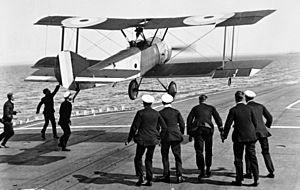
To attack more effectively, navies needed a better way to launch and recover planes. This led to the creation of the aircraft carrier. HMS Ark Royal was one of the first ships built for carrying seaplanes. It could also carry wheeled aircraft and had a launch platform. It was launched in 1914 and served throughout World War I.
The British Royal Navy also experimented with HMS Furious. This ship was changed several times to have flight decks. On August 2, 1917, Squadron Commander E.H. Dunning landed his plane on Furious while the ship was moving. He was the first person to land a plane on a moving ship. Sadly, he died five days later during another landing.
HMS Argus was a ship changed from an ocean liner. It became the first aircraft carrier with a full-length flight deck. This allowed wheeled aircraft to take off and land easily. Argus helped develop the best ways to design and operate aircraft carriers.
The Tondern raid in 1918 was the first attack in history where aircraft flew from a carrier's flight deck. Seven planes launched from HMS Furious and destroyed two German airships.
Between the World Wars

True aircraft carriers, like the ones we know today, started appearing in the early 1920s. Japan's Hōshō (1921) was the world's first aircraft carrier built specifically for that purpose. The British HMS Hermes (1924) was planned earlier. Both ships had a full-length flight deck and a control tower, which are key features of modern carriers.
In the United States, some leaders wanted to reduce naval aviation. However, others, like Franklin Roosevelt, fought to keep it. There were debates about whether battleships or aircraft were more important. Tests were done to see if planes could sink battleships. These tests, especially the sinking of the German ship SMS Ostfriesland, showed the power of air attacks. This helped convince people to support building aircraft carriers. The first U.S. aircraft carrier was USS Langley, converted from a coal ship in 1922.
Many British naval ships also carried floatplanes or seaplanes for scouting. These planes were launched by catapults and landed on the water to be picked up by cranes. Some countries, like Japan and France, even built submarine aircraft carriers that carried one floatplane, but these were not very effective.
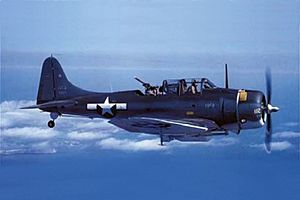
World War II showed how important naval aviation was. Japan, the United States, and Britain used it the most. Aircraft from ships were used in major sea battles, attacks on naval bases, and to support ground troops. They also hunted submarines.
During World War II, the aircraft carrier became the most powerful warship, replacing the battleship. Battles between fleets were often fought by aircraft from far away, not by guns. For example, the Japanese battleship Yamato, the biggest ever built, was sunk by aircraft because it didn't have its own air cover.
In the Doolittle Raid of 1942, U.S. Army bombers launched from the carrier Hornet to bomb Japan. This was a one-way mission, and the planes were lost. Smaller carriers were built in large numbers to protect cargo ships from submarines.
The British also used special merchant ships, called CAM ships and merchant aircraft carriers, to carry a few planes and protect convoys. Later, many escort aircraft carriers were built. These basic ships were not fast or strong enough for big fleet battles, but they provided vital air cover where it was needed, especially against German U-boats in the Battle of the Atlantic.
After seeing how effective naval aviation was, the Royal Navy decided to focus on aircraft carriers instead of battleships. The U.S. also built many carriers.
Other important actions involving naval aviation in World War II included:
- The Attack on Pearl Harbor in 1941, where Japanese carrier planes sank many U.S. warships.
- The sinking of two large British warships by land-based aircraft.
- Major battles like Coral Sea, Midway, and Philippine Sea, which were fought mainly by aircraft.
- The Battle of Leyte Gulf, where kamikaze planes appeared for the first time.
- Operation Ten-Go, which showed how vulnerable surface ships were without air cover.
After World War II
After World War II, jet aircraft started being used on aircraft carriers. The first jet landing on a carrier was in 1945 by Lt Cdr Eric "Winkle" Brown on HMS Ocean. By the mid-1950s, jets were regularly flying from carriers thanks to new inventions.
One important invention was the angled flight deck by British engineers. This deck was angled a few degrees from the ship's center. If a plane missed the landing wires, the pilot could simply speed up and take off again without hitting parked aircraft. The steam-powered catapult was another British invention that made launching heavier jets easier and more reliable. The Mirror Landing Aid also helped pilots land safely.
The U.S. Navy built the first aircraft carrier powered by nuclear reactors, USS Enterprise. This allowed carriers to operate for much longer without needing to refuel.
The helicopter also became very important after the war. Helicopters could do many jobs from carriers and other ships. In the 1950s and 1960s, some older carriers were changed into "Commando Carriers" or "Landing Platform Helicopters" (LPH) to carry only helicopters.
The British also developed the ski-jump ramp for their smaller carriers. This ramp helped VTOL/STOVL jets like the Sea Harrier take off with heavier loads, even from short flight decks.
In 2013, the U.S. Navy successfully launched and landed an unmanned aerial vehicle (UAV), or drone, from an aircraft carrier. The Navy is now working to add more drones to its carrier forces for scouting and attacking.
Naval aviation forces mainly perform tasks at sea. But they also do other jobs depending on the country. Here are some common roles:
Protecting the Fleet
Aircraft from carriers give a country's ships air cover. This means they protect the ships from air attacks in areas where land-based planes cannot reach. This gives them a big advantage over navies without air support.
Showing Military Power
Naval aviation allows countries to send military aircraft over land and sea without needing air bases on land. This helps them project their power around the world.
Clearing Mines
Aircraft can help clear naval mines. A helicopter can tow a special sled through the water to find and clear mines, keeping the aircraft and crew safe from harm. The MH-53E and AW101 are examples of helicopters used for this.
Attacking Enemy Ships
Naval aircraft are also used to attack enemy ships and other surface vessels. They usually do this by launching anti-ship missiles.
Supporting Landings
Naval aviation helps in amphibious warfare, which is when troops land from the sea. Aircraft from ships support marines and other forces as they land and move inland.
Patrolling the Seas
Naval aircraft are used for various maritime patrol missions. These include scouting, search and rescue, and enforcing maritime laws.
Resupplying Ships at Sea
Vertical replenishment, or VERTREP, is a way to supply ships at sea using helicopters. Helicopters move cargo and supplies from supply ships to the flight decks of other naval vessels.
Hunting Submarines
During the Cold War, submarines were a big threat. Navies developed special aircraft carriers and helicopters to hunt submarines. These carriers are smaller and carry many anti-submarine warfare (ASW) helicopters. Land-based maritime patrol aircraft are also good at this job.
Disaster Relief
Naval aircraft are used to help after natural disasters. They can airlift supplies, bring in doctors and relief workers, and rescue people in danger. They are very important when airports or roads are destroyed. Ships can also provide fresh water, which helicopters can then carry to affected areas. Naval aircraft helped a lot after the 2010 Haiti earthquake and Typhoon Haiyan.
- Argentine Naval Aviation (Argentine Navy)
- Fleet Air Arm (RAN) (Royal Australian Navy)
- Bangladesh Naval Aviation (Bangladesh Navy)
- Brazilian Naval Aviation (Brazilian Navy)
- People's Liberation Army Naval Air Force (Chinese People's Liberation Army Navy)
- Republic of China Naval Aviation Command (Republic of China Navy)
- Chilean Naval Aviation (Chilean Navy)
- Colombian Naval Aviation (Colombian Navy)
- Department of Aviation (United States Marine Corps)
- Flotilla de Aeronaves (FLOAN) (Spanish Navy)
- French Naval Aviation (French Navy)
- Marineflieger (German Navy)
- Navy Aviation Command (Hellenic Navy)
- Indian Naval Air Arm (Indian Navy)
- Indonesian Naval Aviation Center (Indonesian Navy)
- Islamic Republic of Iran Navy Aviation (Islamic Republic of Iran Navy)
- Italian Naval Aviation (Italian Navy)
- Fleet Air Force (Japan Maritime Self-Defense Force)
- Air Wing Six (Republic of Korea Navy)
- Royal Malaysian Navy Aviation (Royal Malaysian Navy)
- Mexican Naval Aviation (Mexican Navy)
- Pakistan Naval Air Arm (Pakistan Navy)
- Peruvian Naval Aviation (Peruvian Navy)
- Polish Naval Aviation (Polish Navy)

- Portuguese Naval Aviation (Portuguese Navy)
- Russian Naval Aviation (Russian Navy)
- Royal Thai Naval Air Division (Royal Thai Navy)
- Turkish Naval Aviation (Turkish Navy)
- Ukrainian Naval Aviation (Ukrainian Navy)
- Fleet Air Arm (United Kingdom Royal Navy)
- United States Naval Air Forces (United States Navy)
- Naval Air Force (Vietnam People's Navy)
- K.u.K. Seefliegerkorps (Austro-Hungarian Navy)
- Naval Air Service (Greece) (Greece Navy)
- Imperial Japanese Navy Air Service (Imperial Japanese Navy)
- Netherlands Naval Aviation Service (Royal Netherlands Navy)
- Royal Naval Air Service (UK Royal Navy)
- Soviet Naval Aviation (Soviet Navy)
See also
 In Spanish: Aviación naval para niños
In Spanish: Aviación naval para niños
- Aerial warfare
- Army aviation
- List of naval air forces
- Military aviation
- Modern United States Navy carrier air operations
- Naval air squadron



